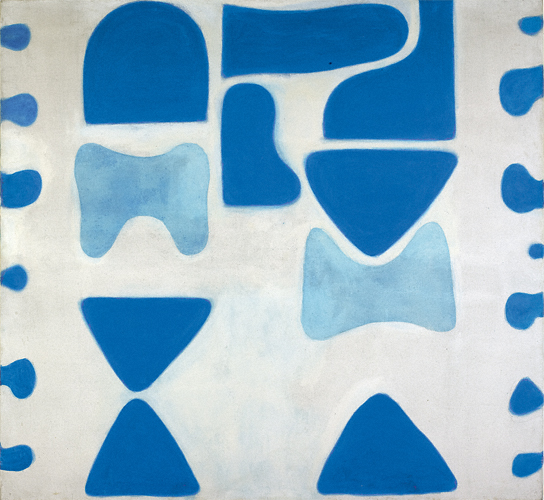Victory in Europe!

This Friday, 8 May, marks the 70th anniversary of VE Day (Victory in Europe Day). Although it was not the end of the war altogether – fighting would continue in the Far East and Pacific until Japan’s surrender in August 1945 – after six years of war in which millions had died, VE Day was at least – as Winston Churchill phrased it – a ‘day off’. And what a day off it was; around the world people of the British Empire and Allied countries celebrated with gusto – singing, dancing and drinking.
In the William Scott Archive, we have a more permanent record of the end of the Second World War – a small work on paper (measuring roughly 9 by 11 inches) by Scott, probably executed in May 1945. It shows a young couple (bearing a strong resemblance to William Scott and his wife Mary) holding hands, their gaze locked, floating above a rural town, born aloft on a white Dove of Peace. The couple hold a banner on which are inscribed the names of the Allied countries – USA, Poland, France, Britain, Russia, Greece and China. It is a poignant image, and an uplifting one (no pun intended!). Together, the dove, the couple and the banner form – albeit loosely – a circle, and it is tempting to read it as a circle of trust and of unity. In the act of flying the couple are, quite literally, moving from one place to another, from the past to the future; riding on the wings of Peace there is a feeling of optimism about what is to come.
Scott himself was all too aware of the brutal reality of the war; his younger brother Hughie, serving in the Royal Marines, had been killed in July 1942 on board the HMS Indomitable in ‘Operation Pedestal’ off the coast of Malta. Scott had volunteered for the navy but was rejected on the grounds that he was ‘too light’. For health reasons, he was also deemed unfit for active combat abroad and instead spent most of the war serving in the Royal Engineers in England. In 1944 he was posted to their map-making division based at Wynnstay Hall in Ruabon, North Wales; on the assumption that artists made good cartographers, a number of painters and graphic designers, including Carel Weight, Henry Cliffe and Arpad Elfer, spent time at Ruabon during the war.
As for many in the armed forces, 8 May 1945 really was only a day off for Scott. In September 1945 he was posted to the Survey Training Centre at Longleat Camp in Wiltshire where he was promoted to a Sergeant in the Army Education Corps, working as an Art Instructor under the Army Education Scheme. Demobilisation was a slow process for most but, by January 1946, Mary Scott had had enough. She went to see the local Army Welfare Officer, brandishing a copy of a recent article published in the New Statesman and Nation in which the critic Roger Marvell had declared, ‘I continue to think Mr. Scott one of the most promising artists in this country and am impatient for his demobilisation.’ It worked. Within a fortnight Scott was released from the army. Grateful for the influential part played by the New Statesman, Scott had evidently written to thank the Literary Editor, Raymond Mortimer, who replied, ‘Dear Mr Scott, What glorious news! If I could really believe that I had helped to liberate you, I should be prouder than Punch.’
For more information contact:
Lucy Inglis – lucy.inglis@williamscott.org

